Rajasthan Board RBSE Class 11 Biology Chapter 10 Nucleus and Chromosomes
RBSE Class 11 Biology Chapter 10 Multiple Choice Objective Questions
Question 1.
Solenoid structure is associated with-
(a) Nucleus
(b) Nucleolous
(c) Chromatin
(d) Nucleoid
Question 2.
The suitable dye for chromatin is-
(a) Safrenin
(b) Acetocarmine
(c) Light green
(d) Aniline blue
Question 3.
Which of the following lacking in bacteria-
(a) DNA
(b) Histone
(c) RNA
(d) All the above
Question 4.
Example of coenocyte is-
(a) Vaucheria algae
(b) Straited muscle cells
(c) Epithelium of Ascaris
(d) All the above
Question 5.
Nuclear membrane originates from which of the following-
(a) Mitochondria
(b) Golgi body
(c) ER
(d) Lysosome
Question 6.
Ribosomes originate from-
(a) Nucleolous
(b) Chromosome
(c) Nuclear membrane
(d) Nucleoplasm
Question 7.
Genetically more active part is-
(a) Chromatin
(b) Euchromatin
(c) Heterochromatin
(d) None of the above
Question 8.
Chromatids are formed during which stage of cell division-
(a) Interphase
(b) Prophase
(c) Metaphase
(d) Telophase
Question 9.
The diploid number of chromosomes in wheat is-
(a) 42
(b) 07
(c) 21
(d) 14
Question 10.
Number of DNA molecule in one chromatid-
(a) One
(b) Two
(c) Four
(d) Many
(1) c, (2) b, (3) b, (4) d, (5) c, (6) a, (7) b, (8) c, (9) a, (10) a
RBSE Class 11 Biology Chapter 10 Very Short Answer Questions
Question 1.
Who discovered nucleus ?
Answer:
Robert Brown.
Question 2.
Which part of chromosomes form nucleolous ?
Answer:
Nucleolar organizer.
Question 3.
Who propound the names enchromatin and heterochromatin ?
Answer:
Emil Heitz.
Question 4.
Which tissue shows triploid chromosomes ?
Answer:
Endosperm of angiosperm.
Question 5.
What is the maximum number of haploid chromosomes in organisms ?
Answer:
Aulocantha.
Question 6.
Which shapes of chromosomes are formed during metaphase ?
Answer:
V, L, J, I shapes.
Question 7.
Name the acidic proteins found in the chromosomes.
Answer:
Non – histone.
Question 8.
Which histone protein is absent in the core particle of nucleosome.
Answer:
H1
Question 9.
Number of nucleosomes in a solenoid coil.
Answer:
3 – 6
Question 10.
Which cell division forms polytene chromosome.
Answer:
Endomitosis.
RBSE Class 11 Biology Chapter 10 Short Answer Questions
Question 1.
Write in brief the morphology of the chromosomes.
Answer:
[Gr.Chroma ⇒ Coloured; Soma ⇒ Body]
The interphase chromatin during cell division form thread – like chromosomes. They were discovered by Stras berger (1875) in plant cell and by Waldeyer (1888) in animal cells.
Number of Chromosomes:
In the somatic and germ cells of animals and higher plants, the number of chromosomes is diploid (2N) whereas in the gametes, the number is haploid (N). The haploid number of chromosomes is called as genome. In the endosperm cells of angiosperms, the chromosome number is triploid (3N). The number of chromosomes in some plants & animals is given in table 10.1
| Cammon name | Scientific name | Diploid Chromosome number(2N) |
|
Pink fungi of |
Neurospora | 14 |
|
Adder’s tongue fern |
Haplopappus gradues |
04(minimum |
| Pca | Ophioglossum r’Iiculatum |
1260 (po1poid) |
| Onion | Pisum salivum | 14 |
| Wheat | Alliuni cepa | 16 |
| Rice | Triticum aesfivum | 42 (Hexaploid) |
| Round worm | Otyza sativa | 24 |
| Radiolarian protozoan | Ascaris megalocephala |
02 (Minimum in |
| Fruit fly | Aulacanta |
1600 (Maximum |
| Man | Drosophila melanogaster | 8 |
| Rabbit | melanogaster | 46 |
| frog | Oryctolag us cuniculus |
44 |
| – | Rana tigerina | 24 |
Shape of Chromosomes:
The shape of the chromosome can be studied during anaphase of mitosis. On the basis of the position of the centromere, the chromosomes are of four types
|
S.No. |
Shape | Position of Centromere | Type of Chromosome |
|
1 |
V – shape |
Centric |
Metacentric |
|
2 |
L – shapc |
Excentric |
Submetacentinc |
|
3 |
J – shape |
Subterminal |
Aeroccntric |
| 4 | I – shape | Terminal |
Teloccntnc |

Structure of the chromosome:
Structure of the chromosome can be studied in the metaphase of mitosis. The chromosomes become thick, condensed & distinct during this phase. During metaphase, each chromosome consists of two chromatids which remain joined at centromere. During anaphase, both the chromatids separated by the division of the centromere and form two daughter chromosomes. During interphase, each chromatid form a coiled chromonemata.
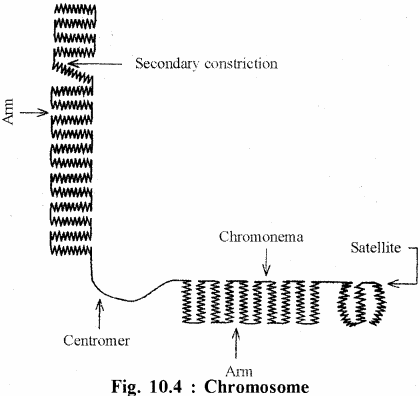
The parts of chromomenata which more coiled are called as chromomeres. The chromomeres bear more genes. The gene is a the unit of heredity. The chromonema may be normally coiled or more coiled or less coiled or not coiled. The region without coiling is called as centromere or primary constriction or kinetochore. It is the site of attachement of the spindle fibres. The sites of chromonemata showing less coiling are called as secondary constrictions. One of the secondary constriction of one chromosome is called as nucleolar organizer which forms the nucleolous. The secondary constrictions are always constant in their position.
The end part of chromosome that is separated from the main body of the chromosome by a secondary constriction is called as satellite. The chromosome with a satellite is called as SAT chromosome. The satellite at metaphase appears to be attached to the rest of the body of chromosome by a thread of chromatin. There are atleast two SAT-chromosomes in each diploid nucleus.
Both the ends of the chromosome remain protected by small segments called telomere. The telomere is a region of repetitive nucleotide sequences. For vertebrates, the sequence of nucleotides in telomeres is TTAGGG with the complementary DNA strant with AATCCC. The telomere can reach a length upto 15000 base pairs. Telomeres were reported by Richard Cawthon & Colleagues. Each time a cell divides, some of the telomere is lost (25 to 200 base pairs). The process of aging in human beings begins with the shortening of the telomeres.
When the telomere becomes too short, the chromosome can no longer replicate. This means the cell becomes old and will die by a process of apoptosis. The telomere is controlled by two mechanisms viz. – erosion & addition. Erosion occurs each time the cell divides. Addition is determined by the activity of telomerase enzyme (Telomere terminal transferase). The cell aging (senescence) is the process by which cell becomes old & dies. It is due to shortning of telomeres.
Chemical composition of chromosome:
The chromosomes consists of following constituents –
1. Nucleic acids – DNA & RNA
2. Proteins – 2 types viz. –
(a) Histones – basic proteins
(b) Non-histones – acidic proteins
3. Mineral ions & salts Ca, Mg, Na etc.
DNA & histone proteins form 90 to 92% part and RNA & non-histone proteins form 8 to 10% part of the chromosome. The account of various histone proteins is given in table 10.3.
Table 10.3 : Various histone proteins
| S.no | Type of histone | Main Amino acid | No. in the Nucleosome of chromosome | Molecular weight |
| 1 | H1 | More 1sin | 1 | 20,000 |
| 2 | H2A | ormaI 1sin | 2 | 13,700 |
| 3 | H2 | More 1v sin & argimne | 2 | 13,700 |
| 4 | H3 | More arginine | 2 | 15,700 |
| 5 | H4 | More argininc | 2 | 11,200 |
Ultrastructure of Chromosome :
The eukaryotic chromosomes consists of many nucleosomes or Nu-bodies. The nucleosome concept of the chromosome was first proposed by Korenberg and Thomas (1974). The term & detailed structure was given by Oudet at al. (1975). It is the most acceptable model and it is also called as solenoid model.
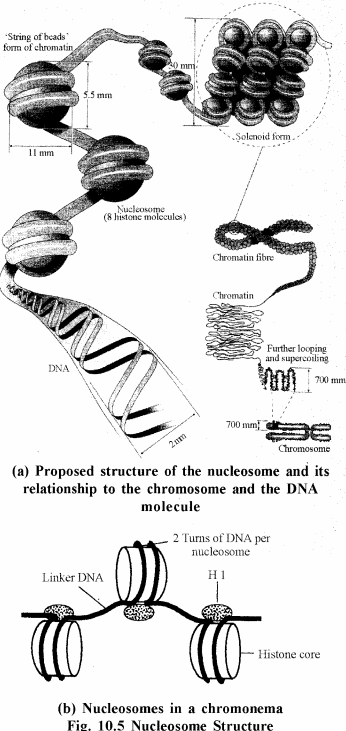
The nucleosomes appear like beads. Each nucleosome consists of core particle and Linker DNA. The core particle is made up of histone octamer ie. having 4 pairs of histone proteins viz. – H2A – 1 pair, H2B – 1 pair, H3 – 1 pair and
H4 – 1 pair. It is surround by 2 coils of DNA. The linker DNA is also called as spacer DNA which is found between two nucleosomes. Each nucleosome is attached with one H1 protein.
The nucleosome containing chromonemata coils spirally to form solenoid structure. Each spiral coil consists of 3 to 6 nucleosomes. This structure was discribed by Finch and Klung (1976). Fore this discovery, Klug was awarded Noble prize of 1982. The diameter of solenoid model varies from 100 to 300nm.
Functions of Chromosomes:
- They are the carrier of hereditory units called genes.
- They have genes which control all the vital activities of the cell/body.
- The NO-part of the chromosome form nucleolous.
- They play active role in cell division.
- Any change in their structure may lead to variations in the animals that help in evolution.
Types of Chromosomes:
The chromosomes are of following types-
- Autosomes – They have genes controlling the general characters.
- Allosomes or Sex chromosomes – They have the genes which determine the sex of the individual.
Special Chromosomes:
They are also called as giant chromosomes & are two types viz. –
(A) Polytene chromosomes
(B) Lampbrush chromosomes.
(A) Polytene Chromosomes
[Poly = many ; tene = strands]
It was was discovered by Balbiani (1881). It is a special chromosome found in the cells of the salivary gland of larva of dipteran insects such as Drosophila, Chironomus, mosqutoes. It is a type of giant chromosome and it is formed as result of endomitosis. The cells bearing such chromosome never undergo cell division.
It has many puffed and unpuffed regions. The puffed regions bear special Balbiani rings. The unpuffed regions “consists of alternate bands and interbands. The bands are the more coiled regions. It has many chromatids which remain attached to a common part called chromocentre. The cell containing polytene chromosome has a metabolic advantage as multiple copies of genes permit high level of gene expression.
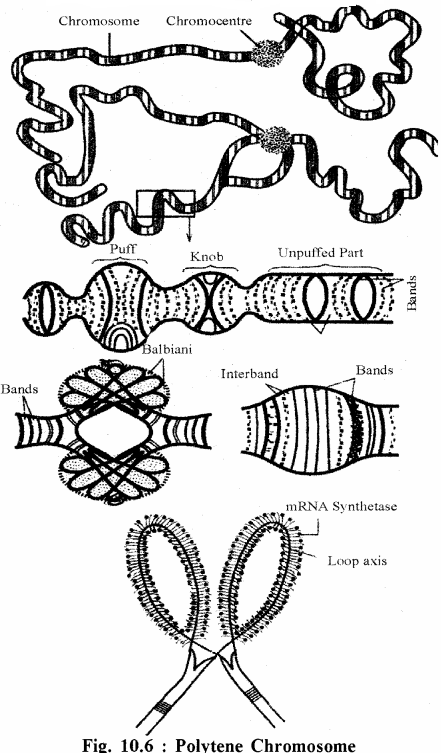
(B) Lamphrush Chromosome:
It was discovered by Walther Flemming (1882), It was described by Ruckert (1892) in the oocytes of shark. It is found in the primary oocytes of Sharks (fishes), amphibians, reptiles and birds. This chromosome is brush – like in appearance. The normal length is 800 to 1000 micron but it may reach upto 5900 micron in urodele oocytes.
If consists of a longitudinal axis that bears two chromatids and several hundred bead – like chromomeres arranged in linear fashion. Each chromere gives out 2 or 4 or 6 lateral loops. These lateral loops give brush-like appearance. The loop axis is surrounded by RNA & proteins. The lambrush chromosome synthesize RNA, yolk & proteins.
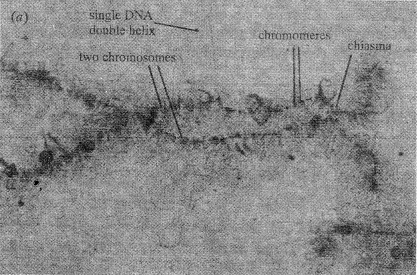
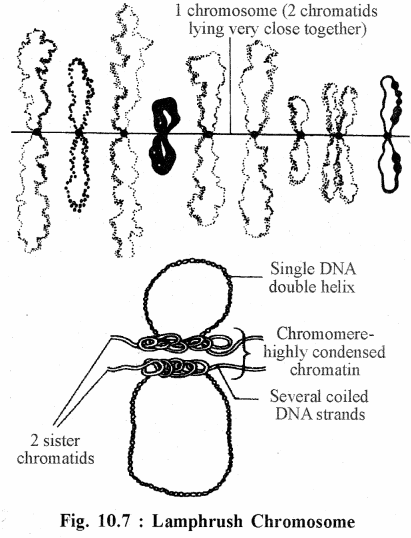
Accessory or Supernumerary Chromosomes:
They were discovered by Wilson (1905). They are extra chromosomes other than normal chromosomes. They are also called as B-Chromosomes.
They are found in varieties of insects and some higher plants such as maize.
Salient Features :
- They are very small and heterochromatin in nature.
- They do not form pair during meiosis & become invisible.
- They are inert genetically and do not effect phenotype.
- They are formed by breaking of the chromosomes.
Question 2.
Give the main functions of nucleus.
Answer:
The nucleus is an important organelle of the eukary otic cells. It contains DNA that controls all the metabolic activities.
Question 3.
What is satellite chromosome.
Answer:
The end part of chromosome that is separated from the main body of the chromosome by a secondary constriction is called as satellite. The chromosome with a satellite is called as SAT chromosome.
Question 4.
What is chromatids ?
Answer:
During metaphase, each chromosome consists of two chromatids which remain joined at centromere.
Question 5.
Give the names & functions of two giant chromosomes.
Answer:
- Polytene Chromosome – It permits high level of gene expression.
- Lampbrush Chromosome – It synthesis RNA, yolk and proteins.
Question 6.
Differentiate coenocyte and syncytium.
Answer:
The multinucleated plant cell is called as coenocyte and the multinucleated animal cell is called as syncytium.
Question 7.
Describe in brief the structure of nucleolous.
Answer:
It is discovered by Fontana (1781) and the name was given by Bowman (1840). It remains distinct & visible during interphase, it disappears during prophase & reappears during telophase.
Question 8.
Write in short about nucleosome.
Answer:
The nucleosomes appear like beads. Each nucleosome consists of core particle and Linker DNA. The core particle is made up of histone octamer i.e. having 4 pairs of histone proteins viz. – H2A – 1 pair,H3B – 1 pair, H4 – 1 pair and
H2 – 1 pair. It is surround by 2 coils of DNA.
Question 9.
What is heteropycnosis ? Give its types.
Answer:
Taking of more stain being more tightly coiled and less stain being less coiled is called as heteropycnosis.
Question 10.
Differentiate the following-
(i) Eukaryotic & prokaryotic nuclei
Answer:
Prokaryotic nucleus is without nuclear membrane. Where as eukaryotic nucleus is bounded by nuclear membrane.
(ii) Enchromatin & heterochromatin
Answer:
Less coiled & stained parts in the chromosome are called as euchromatin and more coiled & stained parts are called as heterochromatin.
(iii) Chromosome & chromatid
Answer:
Chromatid is a part of chromosome which is formed during cell division.
(iv) Primary & secondary constructions.
Answer:
Less coiled part in chromosome is called as secondary constriction. The uncoiled region is called as primary constriction.
RBSE Class 11 Biology Chapter 10 Essay Type Questions
Question 1.
Describe structure of nucleus. Give suitable diagram.
Answer:
The eukary otic nucleus consists of following parts –
- Nuclear membrane
- Nucleolous
- Chromatin material.
1.Nuclear membrane
The nucleus is bounded by an envelope of two unit membranees having thickness of 85A°. There is a perinuclear space or intermembranous space between the two membranes having width 10 to 50 nm. The nuclear membrane bears nuclear pores of diameter about 300 to 400A°. The outer nuclear membrane is attached with ribosomes. The nuclear is formed by the ER at the end of the mitosis in telephase. The nuclear pore has a pore complex of granules & connections.
2. Nucleolus
There is one or two or more nuclei in the peripheral region of the nucleus. It is round and not bounded by any membrane.
It is discovered by Fontana (1781) and the name was given by Bowman (1840). It remains distinct & visible during interphase, it disappears during prophase & reappears during telophase.
The nucleolous remain associated with the nucleolar organizer part (No-part) of a chromosome. Structurally, the nucleolus consists of four types of structures viz. –
- Fibrilar part – It includes small fibres of ribonucleo proteins. Their length is about 50 to 80A° and they are also called as nucleonema.
- Granular part – They are small granules made up of RNA & proteins. Their diameter is about 150 to 200A°. They are also called as nucleolar ribosomes. They form the ribosomes.
- Amorphous part – It is the homogenous liquid part of the nucleolous. The fibrils and granules remain suspended in it. It is also called as matrix & made up of mainly proteins.
- Nucleolar Chromatin – They are made up of DNA and are of two types viz. –
(a) Intranucleolar chromatin
(b) Perinucleolar chromatin
Chemically, the nucleolous consists of 85% proteins, 10% rRNA & 5% DNA. The primary function of the nucleolous is to form ribosomal subunits.
3. Nucleoplasm:
It is homogenous, semiliquid, granular, clear & colloidal solution found in the nucleus. The rest parts (nucleolous & chromatin) of the nucleus remain suspended in it. It is also called as nuclear sap or karyolymph or karyoplasms. It consist of proteins, DNA, RNA, nuclear enzymes etc.
4. Chromosomes:
During inter phase, the nucleus consists of network of minute thread – like structures called chromatin material (Flemming). The chromatin material form chromosomes during cell division. The chromatin material can be strained by acetocarbin dye. Emil Heitz (between 1928 & 1935) differentiated chromosomes in euchromatin (genetically active) and heterochromatin (genetically inert).

Question 2.
Describe structure of chromosome with the help of diagram.
Answer:
Structure of the chromosome can be studied in the metaphase of mitosis. The chromosomes become thick, condensed & distinct during this phase. During metaphase, each chromosome consists of two chromatids which remain joined at centromere. During anaphase, both the chromatids separated by the division of the centromere and form two daughter chromosomes. During interphase, each chromatid form a coiled chromonemata.

The parts of chromomenata which more coiled are called as chromomeres. The chromomeres bear more genes. The gene is a the unit of heredity. The chromonema may be normally coiled or more coiled or less coiled or not coiled. The region without coiling is called as centromere or primary constriction or kinetochore. It is the site of attachement of the spindle fibres. The sites of chromonemata showing less coiling are called as secondary constrictions. One of the secondary constriction of one chromosome is called as nucleolar organizer which forms the nucleolous. The secondary constrictions are always constant in their position.
The end part of chromosome that is separated from the main body of the chromosome by a secondary constriction is called as satellite. The chromosome with a satellite is called as SAT chromosome. The satellite at metaphase appears to be attached to the rest of the body of chromosome by a thread of chromatin. There are atleast two SAT-chromosomes in each diploid nucleus.
Both the ends of the chromosome remain protected by small segments called telomere. The telomere is a region of repetitive nucleotide sequences. For vertebrates, the sequence of nucleotides in telomeres is TTAGGG with the complementary DNA strant with AATCCC. The telomere can reach a length upto 15000 base pairs. Telomeres were reported by Richard Cawthon & Colleagues. Each time a cell divides, some of the telomere is lost (25 to 200 base pairs). The process of aging in human beings begins with the shortening of the telomeres.
When the telomere becomes too short, the chromosome can no longer replicate. This means the cell becomes old and will die by a process of apoptosis. The telomere is controlled by two mechanisms viz. – erosion & addition. Erosion occurs each time the cell divides. Addition is determined by the activity of telomerase enzyme (Telomere terminal transferase). The cell aging (senescence) is the process by which cell becomes old & dies. It is due to shortning of telomeres.
Chemical composition of chromosome:
The chromosomes consists of following constituents –
- Nucleic acids – DNA & RNA
- Proteins – 2 types viz. –
(a) Histones – basic proteins
(b) Non-histones – acidic proteins - Mineral ions & salts Ca, Mg, Na etc.
DNA & histone proteins form 90 to 92% part and RNA & non-histone proteins form 8 to 10% part of the chromosome. The account of various histone proteins is given in table 10.3.
| s.no | Type of histone | Main Amino acid | No. in the Nucleosome of chromosome |
Molecular weight |
| 1 | H1 | More 1sin | 1 | 20,000 |
| 2 | H-,A | ormaI 1sin | 2 | 13,700 |
| 3 | H2B | More 1v sin & argimne | 2 | 13,700 |
| 4 | H3 | More arginine | 2 | 15,700 |
| 5 | H4 | More argininc | 2 | 11,200 |
Question 3.
What is polytene chromosome ? Give its structure & function.
Answer:
They are also called as giant chromosomes & are two types viz. –
(A) Polytene chromosomes
(B) Lampbrush chromosomes.
(A) Polytene Chromosomes:
[Poly = many ; tene = strands]
It was was discovered by Balbiani (1881). It is a special chromosome found in the cells of the salivary gland of larva of dipteran insects such as Drosophila, Chironomus, mosqutoes. It is a type of giant chromosome and it is formed as result of endomitosis. The cells bearing such chromosome never undergo cell division.
It has many puffed and unpuffed regions. The puffed regions bear special Balbiani rings. The unpuffed regions “consists of alternate bands and interbands. The bands are the more coiled regions. It has many chromatids which remain attached to a common part called chromocentre. The cell containing polytene chromosome has a metabolic advantage as multiple copies of genes permit high level of gene expression.
